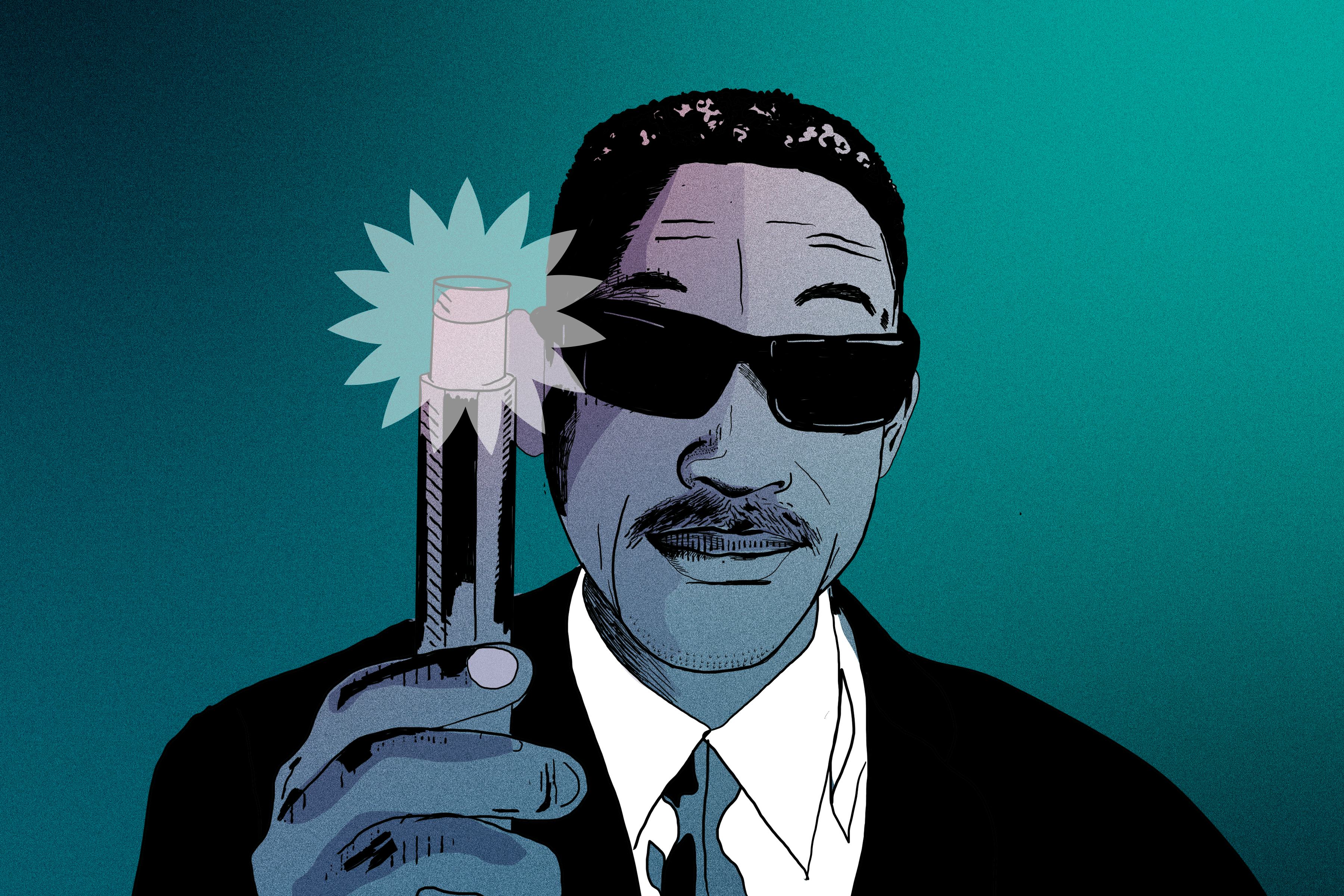
Men in Black changed the game for alien movies.
There had, of course, been films about aliens for decades. But, with the help of rapidly-developing computer software and legendary prosthetics artist Rick Baker (who won an Oscar for his work on the film), the Will Smith and Tommy Lee Jones vehicle made the world take notice. To paraphrase Smith, MIB made aliens look good.
Even though director Barry Sonnenfeld had The Addams Family under his belt, Smith was fresh off Independence Day, and Jones had just won an Oscar, the film was a difficult one to make. Ed Solomon, who wrote the screenplay, tells Inverse that he was fired four times (and hired five times) in the process.
“The making of the film was very stressful for me,” Solomon says. “The multiple years; the multiple, multiple, multiple drafts…”
Sonnenfeld’s perfectionism and Jones’ struggles with comedy also meant that, though the end result was a brilliant balancing of science fiction and dark comedy, it wasn’t achieved without a lot of hard work. Several key members of the crew either tell Inverse that they didn’t get on with Jones and that he made their work more difficult, or diplomatically avoid commenting on him, heaping praise on Smith.
These problems pale in comparison with the positive stories, however, and Men in Black was blessed from the moment it arrived. 25 years after the film landed in cinemas (setting various box office records), Inverse spoke to 14 key members of the production to get the lowdown on how Men in Black overcame its challenges to transform a genre.
“There are legends”
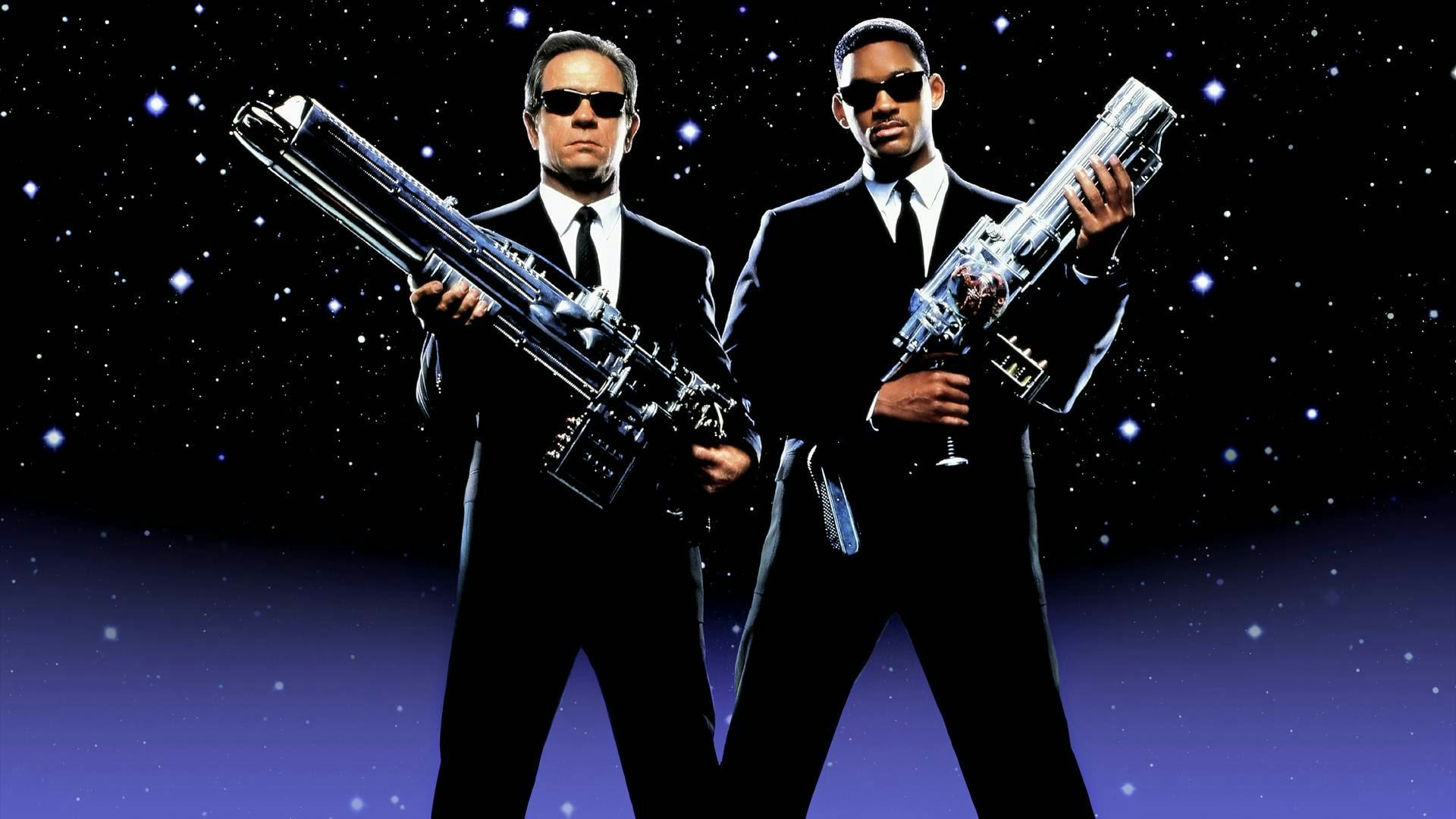
Lowell Cunningham (writer of the original The Men In Black comic): There are legends of people like the Men in Black, going back hundreds if not thousands of years. I was introduced to the legend by a friend of mine named Dennis Matheson. He and I were traveling through the local student neighborhood where I lived at the time, and we saw a huge black car drive by, and he said, “That looks like the kind of car the Men In Black would drive.” I was looking for a home for the idea and another friend of mine had been doing artwork for comics for a company called Malibu. I was 28-ish. So I wrote up a sample script and mailed it off.
Ed Solomon (screenwriter): I read it. I thought there was a really great concept in what Lowell did but tonally, for me, I thought to be a film it needed to be a comedy if the premise was, the aliens already live here and we just don’t know it.
Lowell Cunningham: My experience was all dealing with comic books, not movies. There was some talk in the contract as to whether they should insist that I basically do a first draft and actually I said no to it because I was not ready.
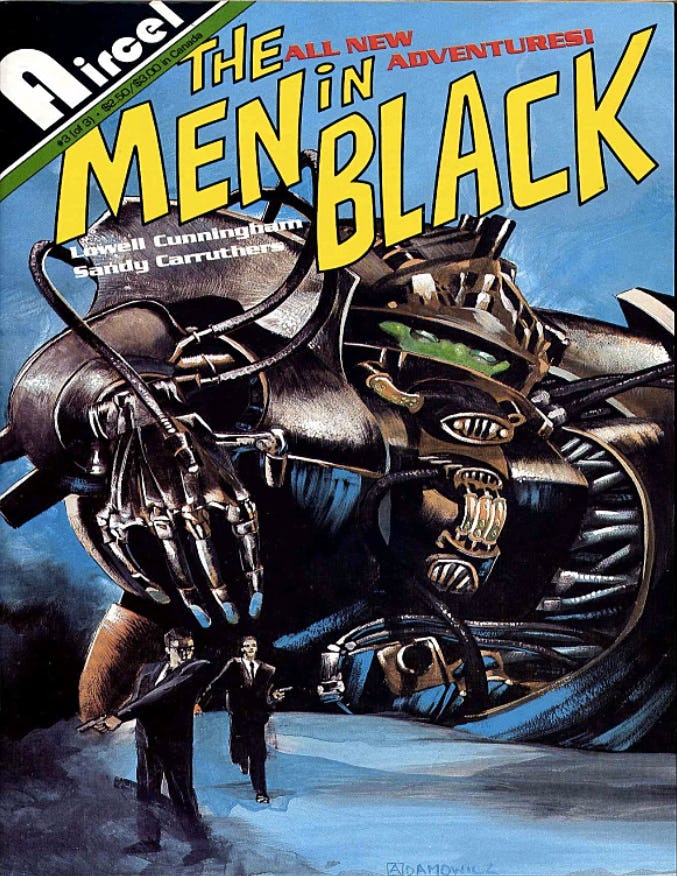
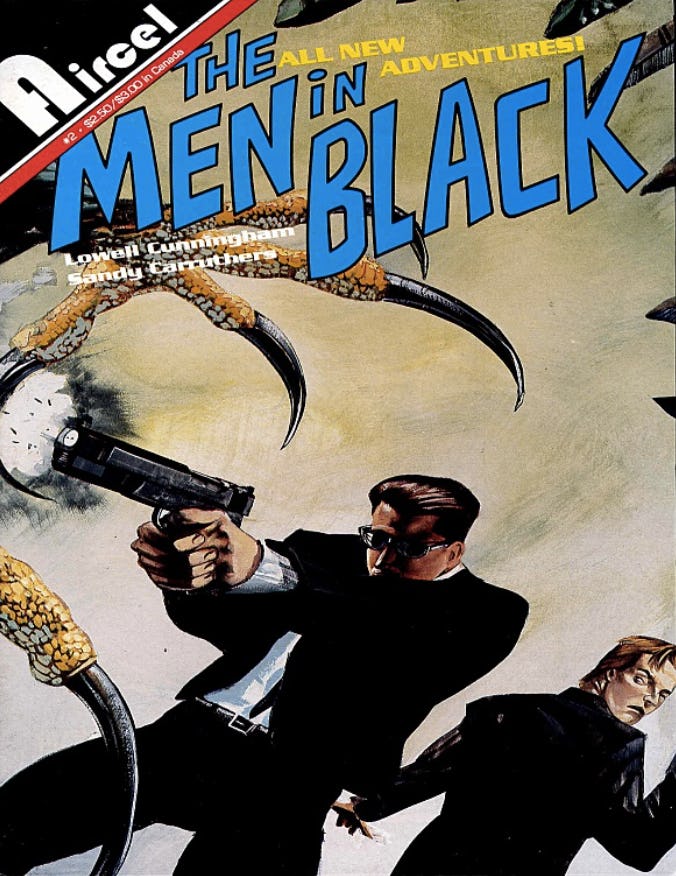
Ed Solomon: The central premise was, “The only thing worse than aliens arriving on your planet is aliens suddenly leaving your planet.” It turned out there was this event happening that initially seemed like a giant threat to the Earth, but, in fact, the humans were causing all the problems. The first person that we brought in was Tommy Lee Jones. He said I needed to make up my mind whether it was a comedy or science fiction, and that it couldn’t be both. I said it wasn’t good enough science fiction to be dramatic. Comedy would allow the leaps of faith needed for this to work. So I was asked to do a draft that was more dramatic and which made him the lead. But I argued that that wasn’t a good idea because it’s a world-build notion and he already knows the world. They brought in Dave Koepp, who did a really great job at breaking the spine in a different way. Then I was hired back and did a pretty massive overhaul of the stuff.
Barry Sonnenfeld (director): I was sent two copies because my wife and I read scripts together. We finished at the same time and I turned to her and said, “Tommy Lee Jones.” And she turned to me and said, “Will Smith.”
Bo Welch (production designer): Sonnenfeld sent a script. I read it. I saw something there that I thought felt good. I was hooked.
“The studio really wanted Clint Eastwood.”
Barry Sonnenfeld: The studio really wanted Clint Eastwood. It was me who asked for Tommy, and then I almost got screwed — they couldn’t hire me because Tommy had director approval. Tommy gave me approval.
Ed Solomon: Barry actually wanted to switch the story from taking place all over the country to being all in New York City because he believed that aliens live there more. He said, “I want it to be like French Connection but with aliens.” We turned J into a cop rather than a Secret Service guy and made it more like beat cops in Manhattan, except it’s aliens.
Barry Sonnenfeld: I kept saying, “If aliens exist, they’re in New York.” And they’re in New York because they can pass. They don’t even have to wear disguises.
Bo Welch: You’re riding in the van, you pass some strange-looking but typical New Yorkers, and we would go, “Alien. Alien. Alien. Not alien.”
MIB headquarters
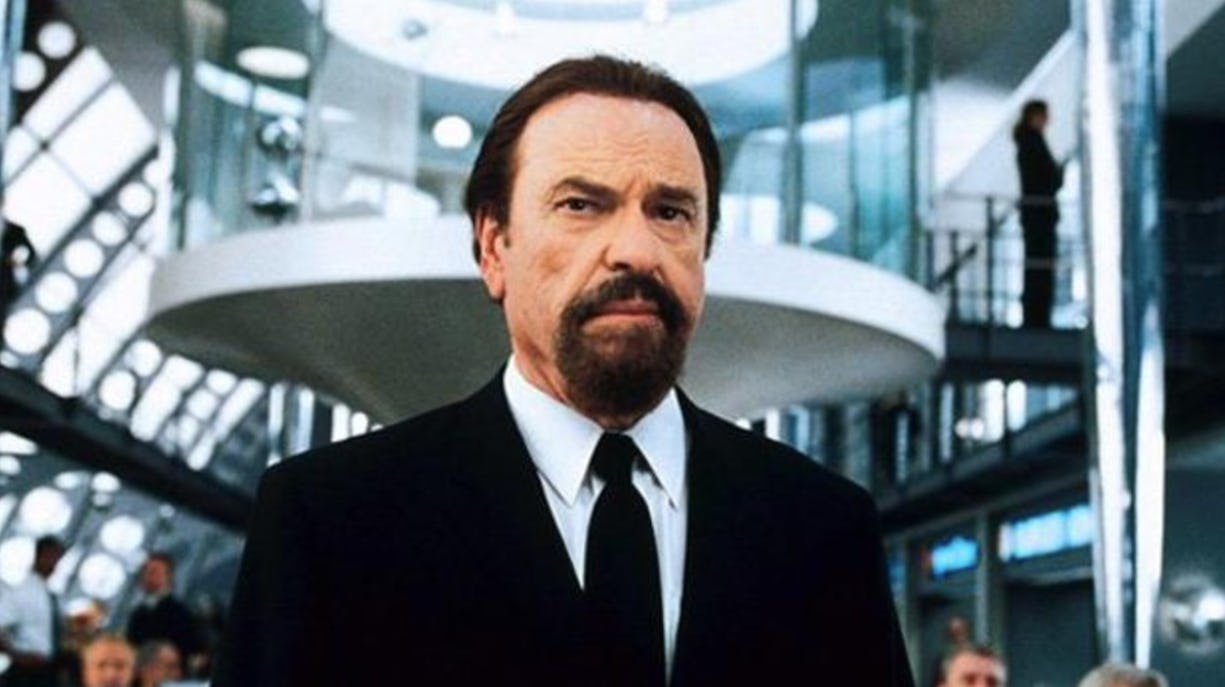
Bo Welch: I took a strong cue from the title. So to me, they wore black suits, their car was black, their world was black and white. So the palette became blacks, whites, neutrals, silvers, metallics.
Mary E. Vogt (costume designer): I was making suits that were early ‘60s but no shoulder pads — FBI suits. When I went to the art department for a visit, I saw this gigantic model that someone was building of this beautiful set. I was like, “Who are you building this for?” And they said, “What are you talking about, this is the Men in Black headquarters.” It looked like the Apple Store before the Apple Store happened.
Bo Welch: It was totally constructed on a sound stage at Sony. It happens to be tremendously long. They [the Men in Black] had money because in policing aliens they stumble across inventions like Velcro, and then they were able to afford this fabulous, rooted-in-the-60s airport terminal. Barry was just instantly, “Oh yeah. ABSOLUTELY.”
Behind-the-scenes images and concept art courtesy of Thomas Duffield. Article continues below.
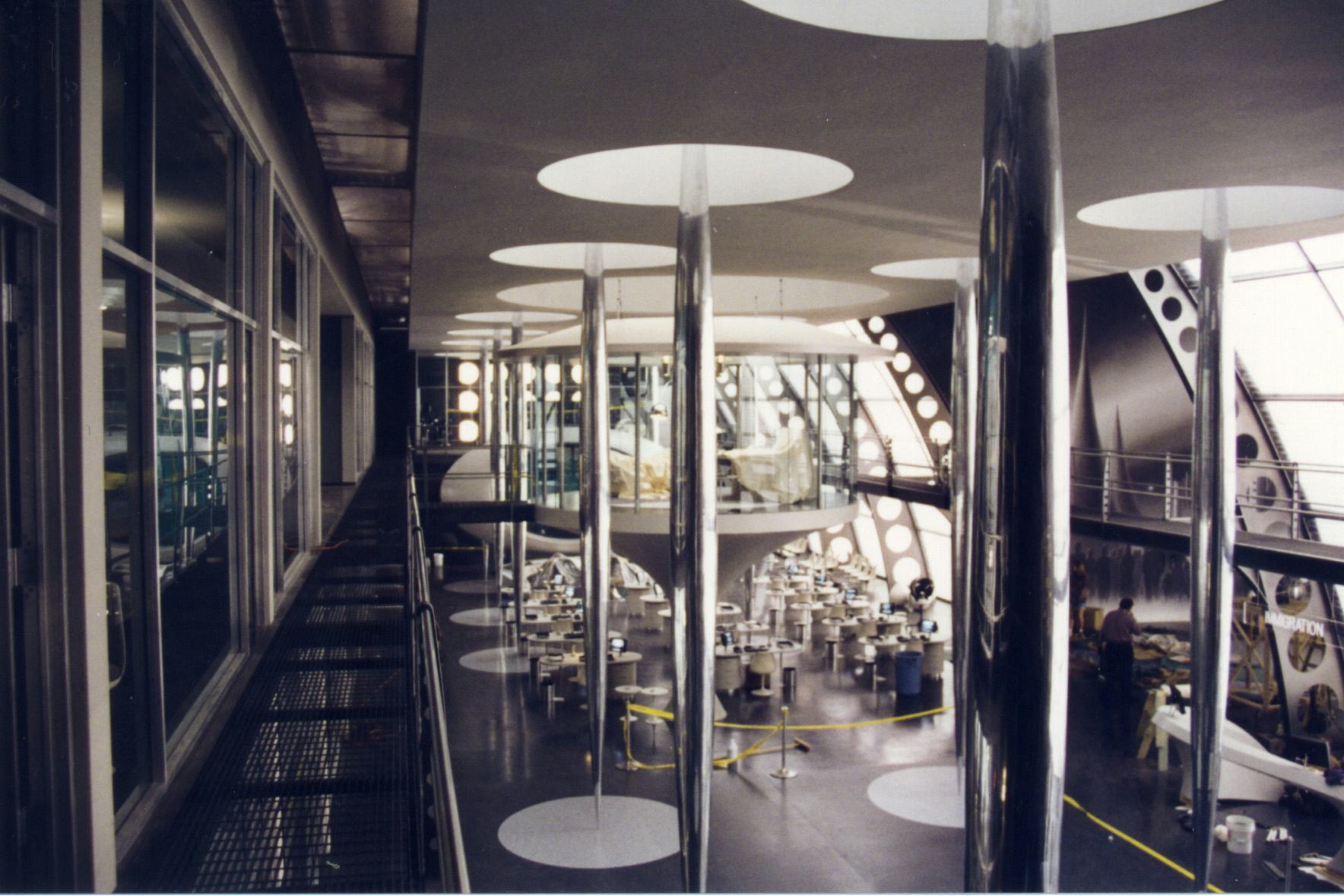
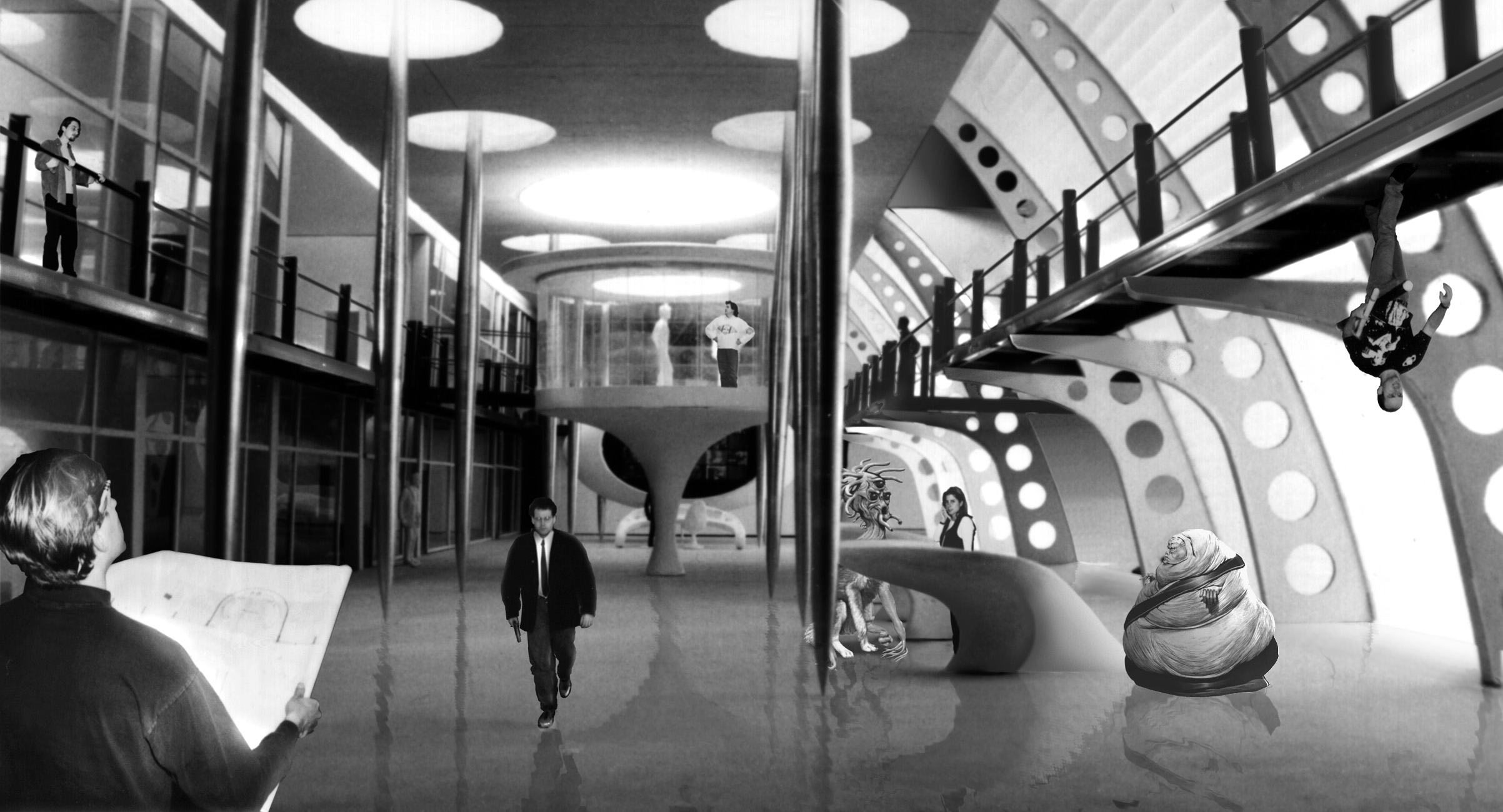
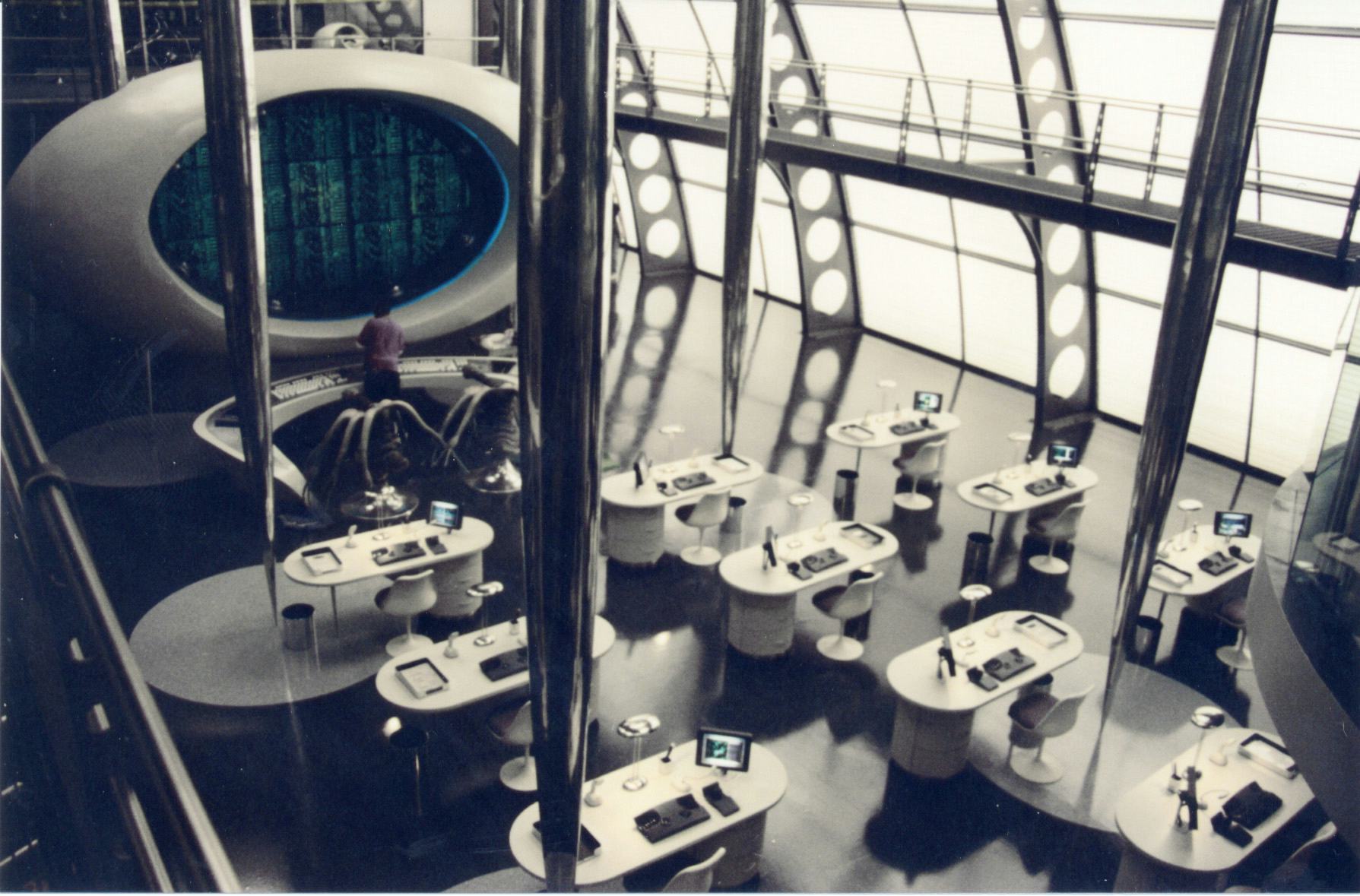
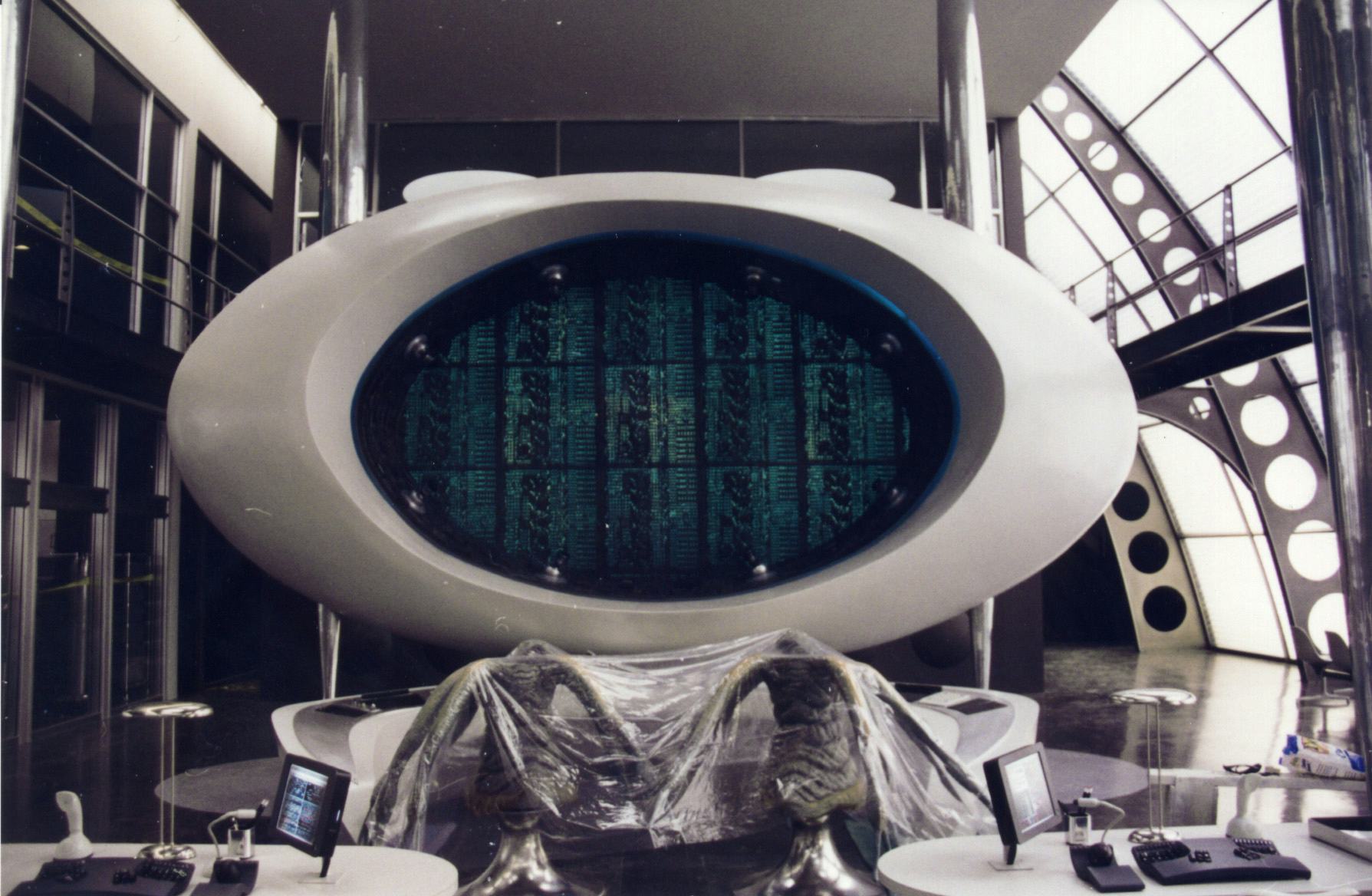
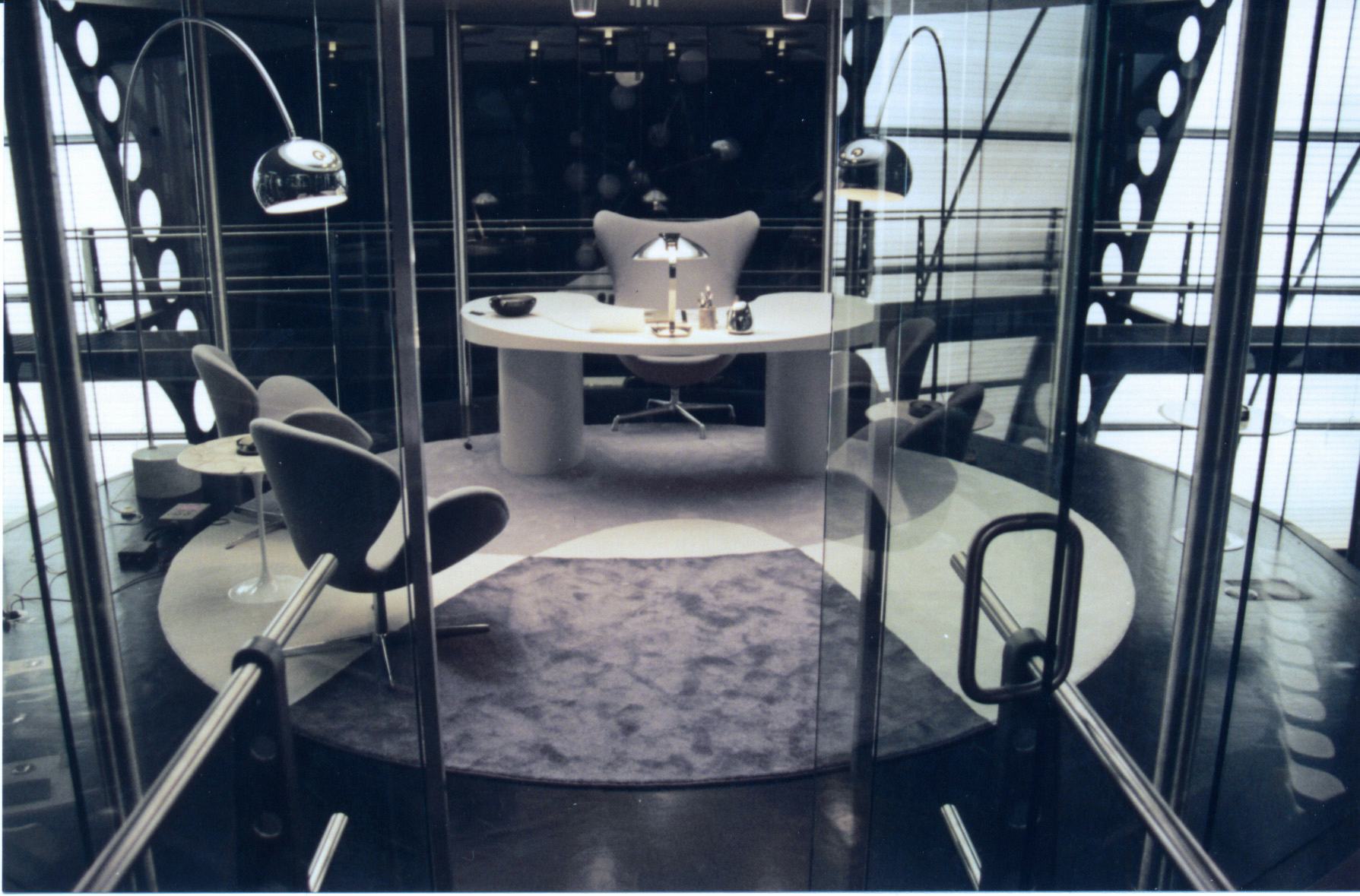
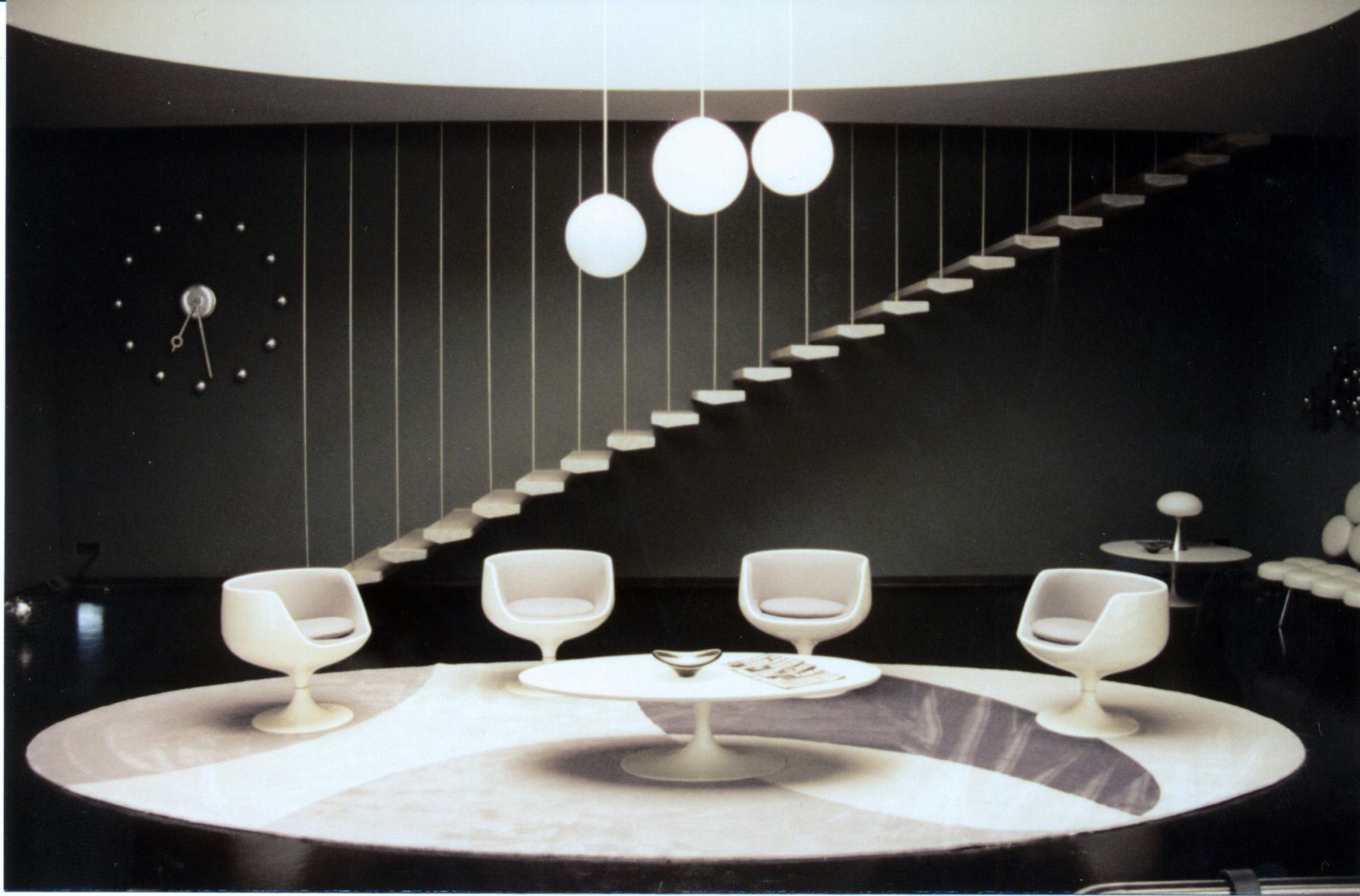
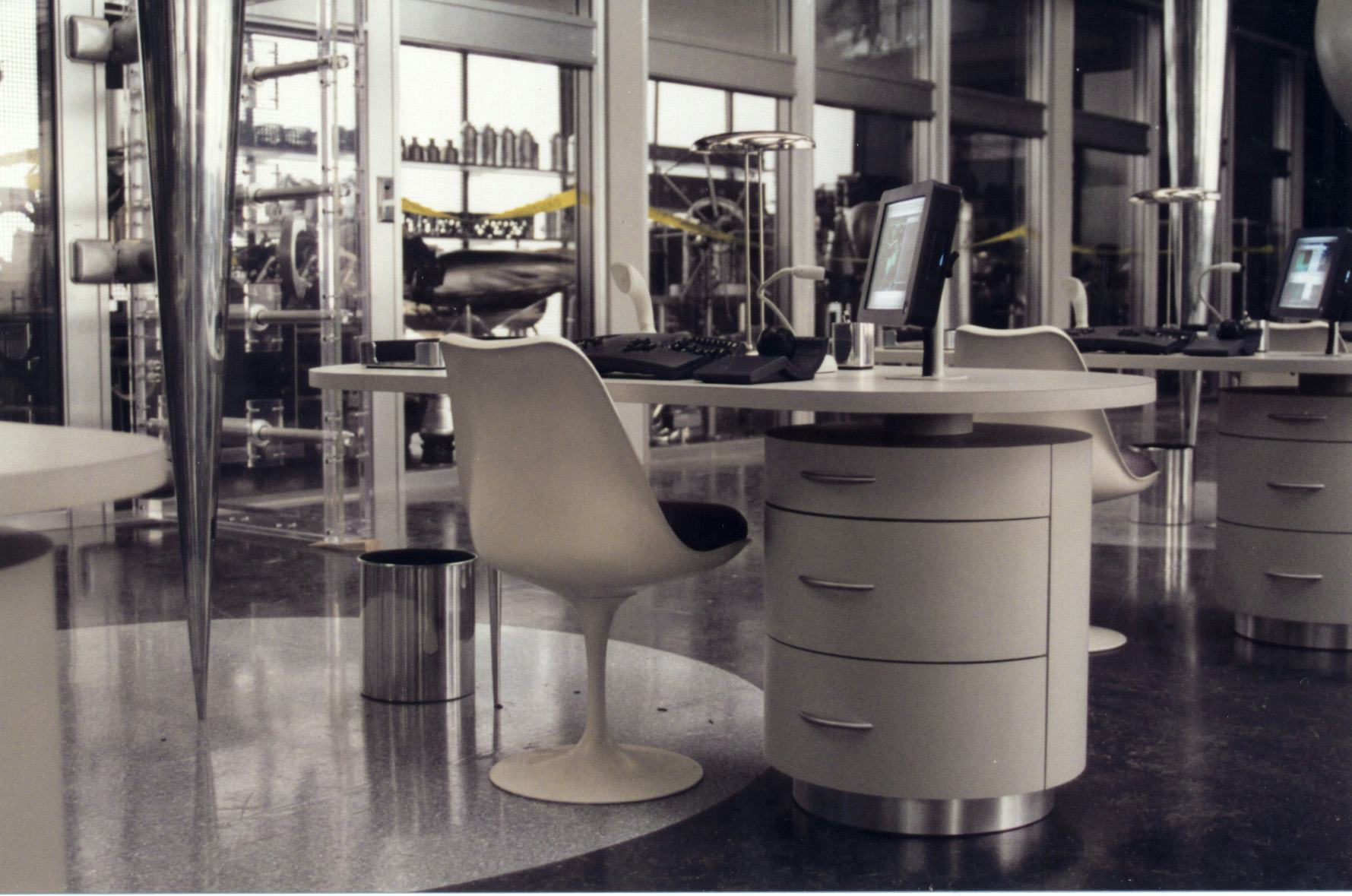
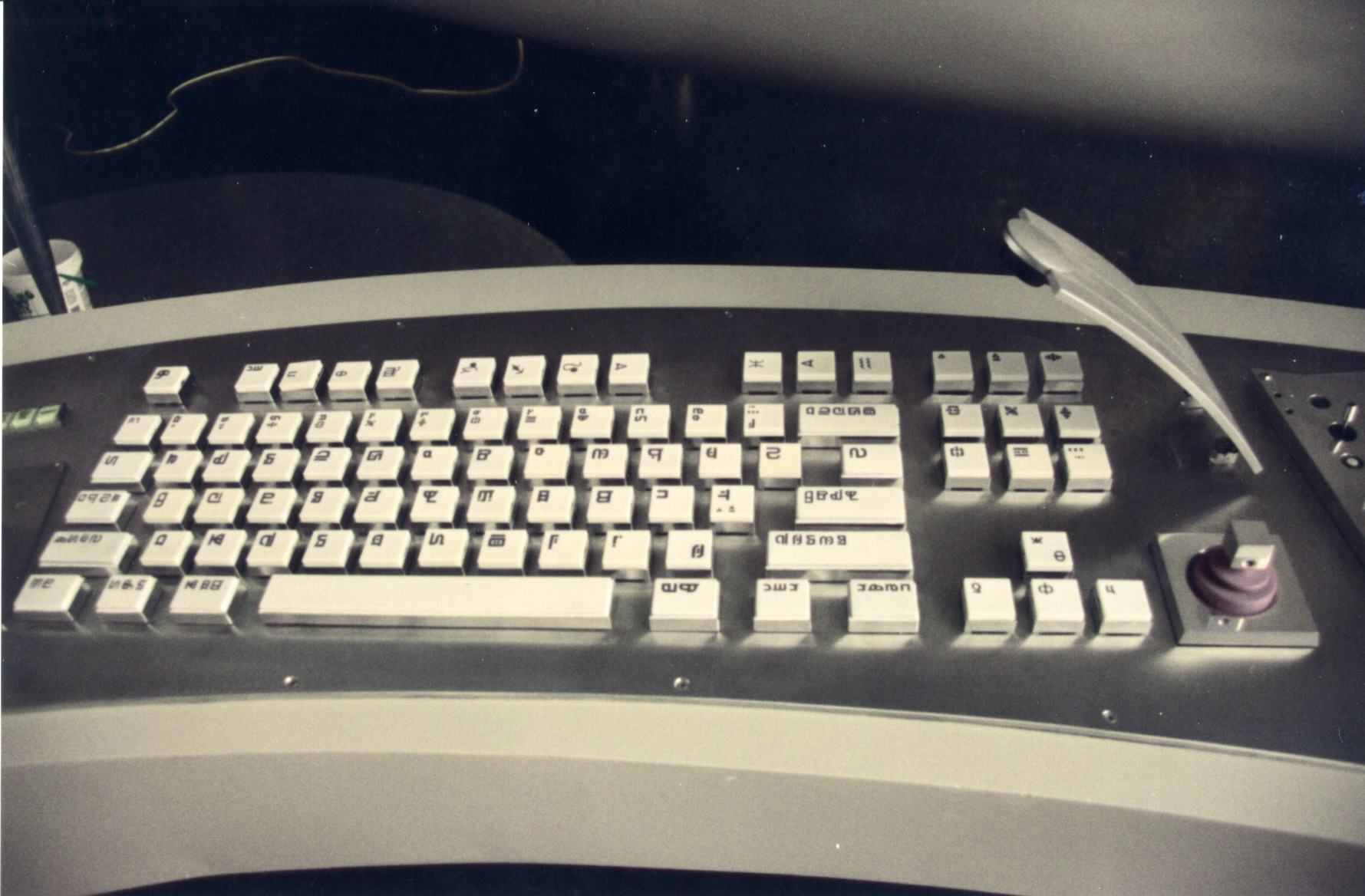
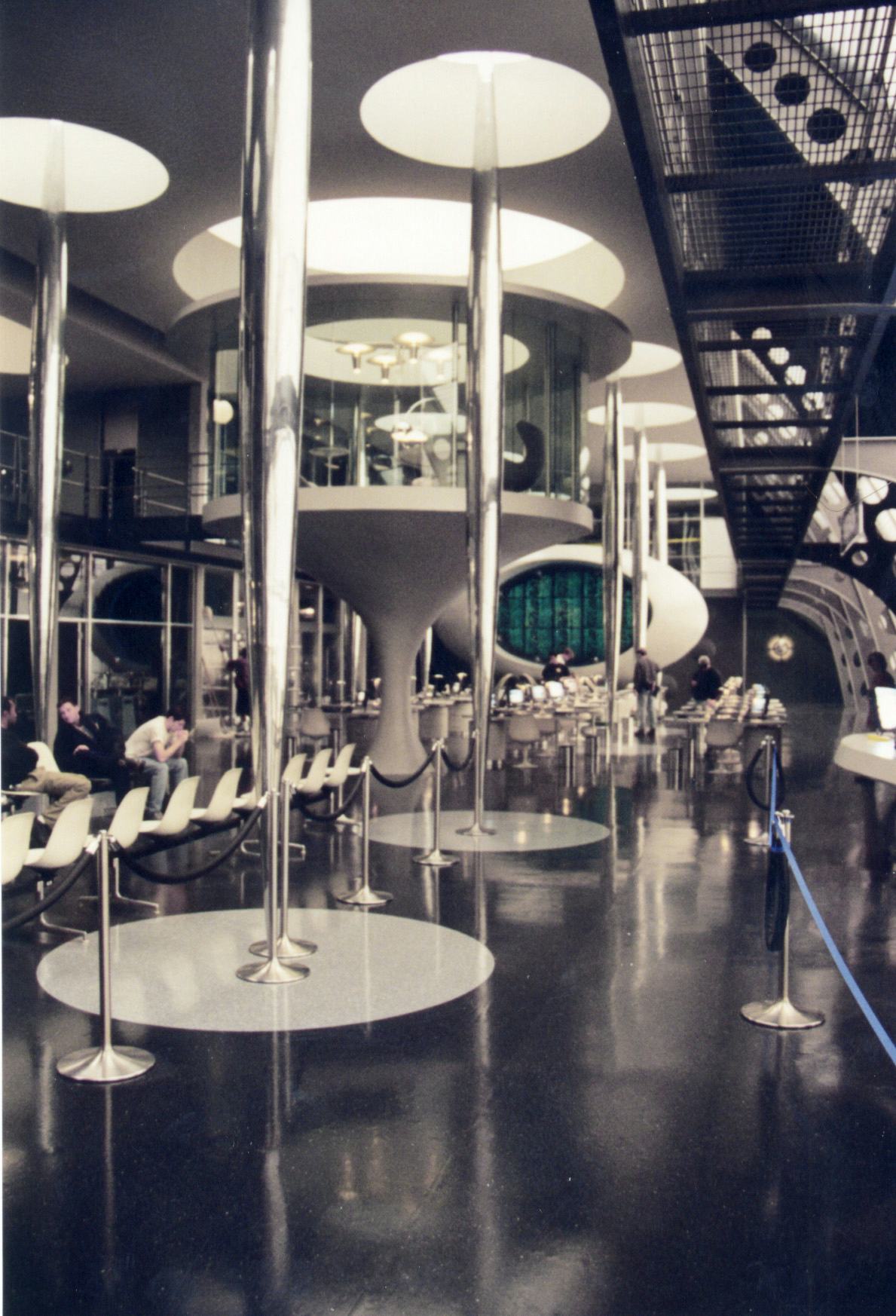
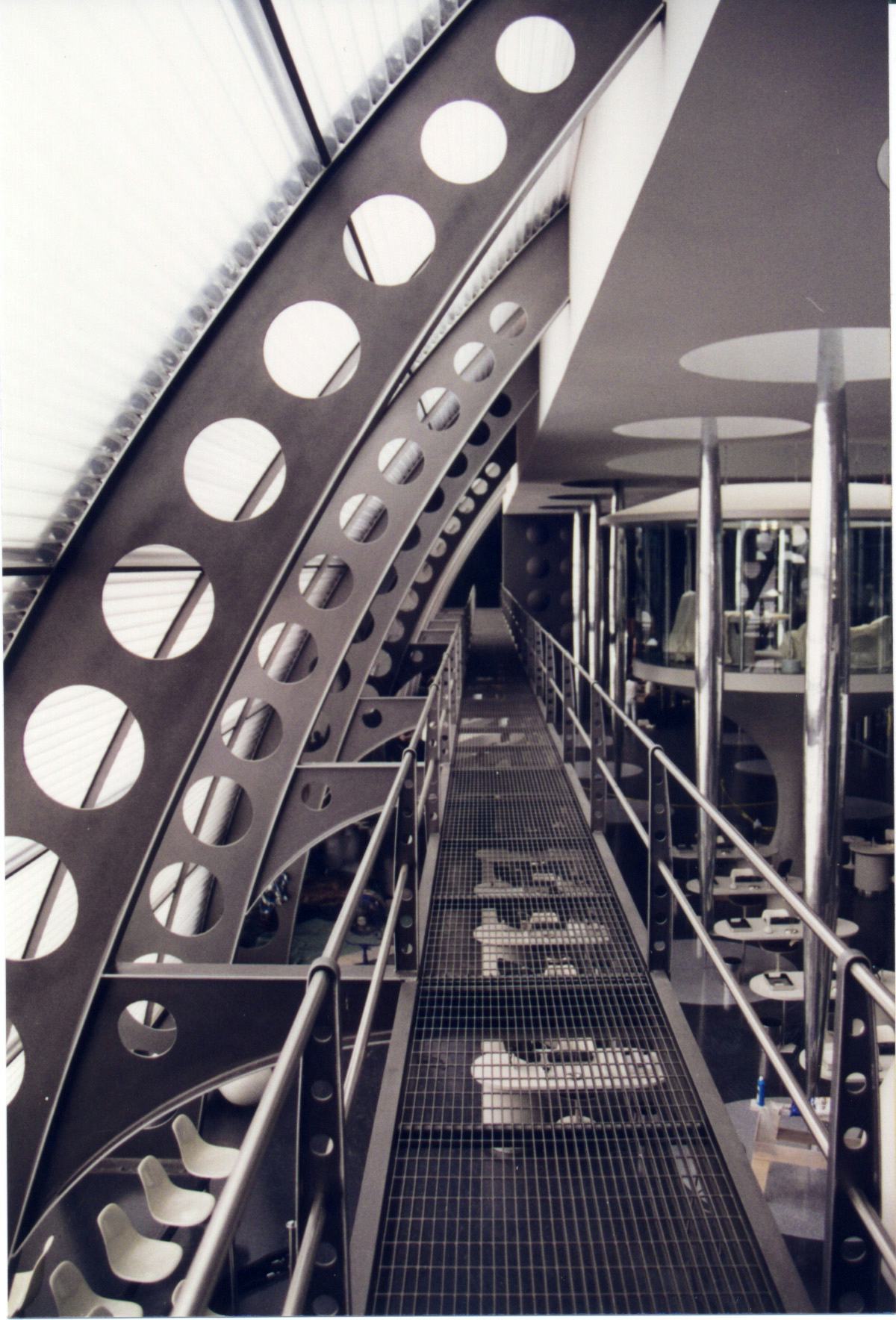
Mary E Vogt: So that’s when I had to scramble and come up with a different suit.
Carel Struycken (actor, Arquillian): I think they were claiming that it was one of the most expensive sets ever built.
Thomas Duffield (art director): We made the fiberglass columns. Bo always thought it was funny to have columns with tiny points at each end that looked like they couldn’t support anything.
Bo Welch: They were probably 35 feet tall. I wanted them to look like chrome. So we had brilliant sculptor plasterers who spun that shape out of fiberglass and foam; coated them; but then the polished metal finish involved spraying some horribly toxic metallic material onto the body of that thing and then grinding and buffing it to perfection.
Thomas Duffield: Since then they said that technique is hazardous and no one can do it any more.
“Edgar, your skin’s hanging off your bones”
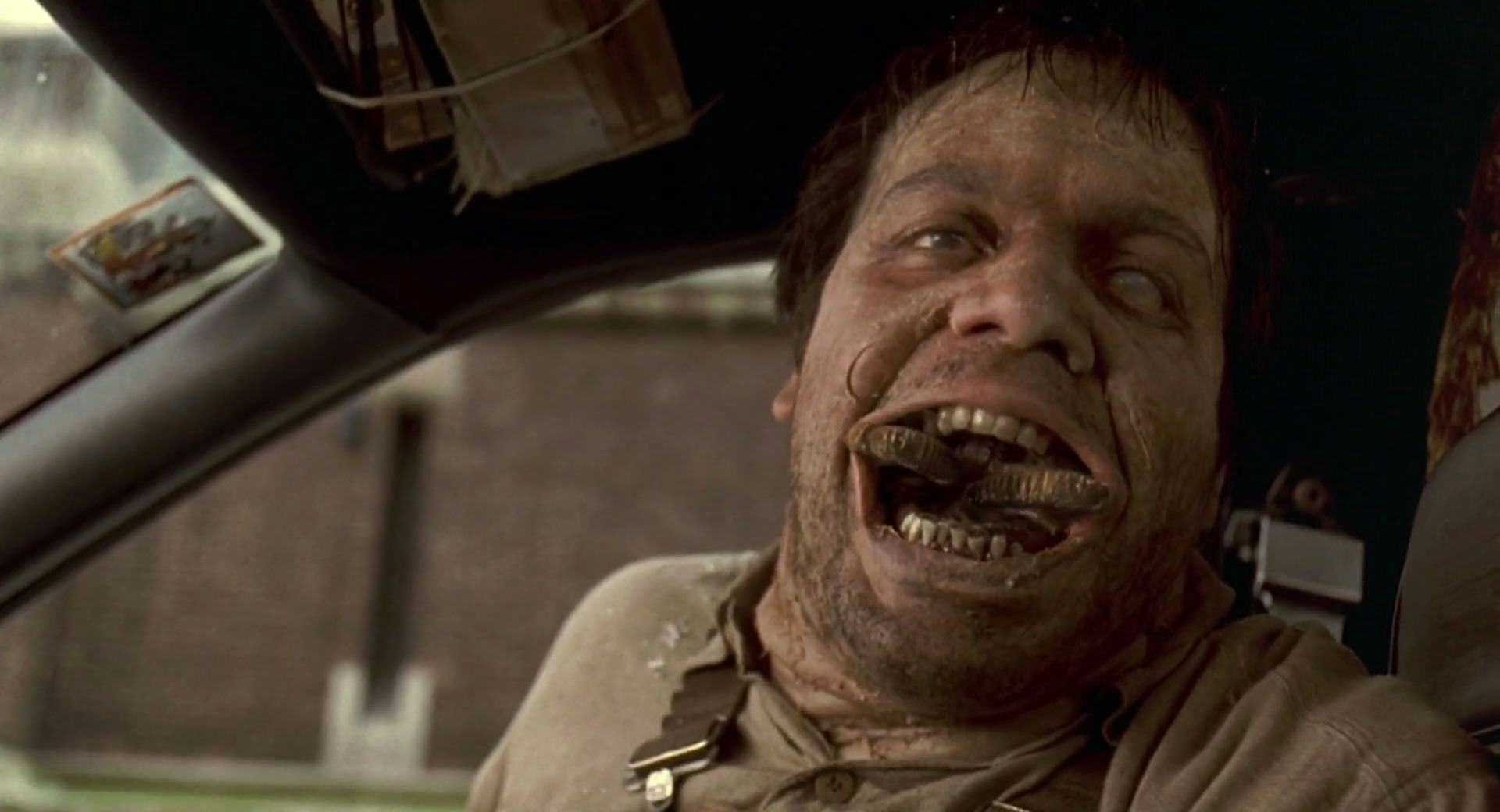
Siobhan Fallon Hogan (actor, Beatrice): There was a snowstorm. I had a babysitter and went to the audition. I buzzed up to Barry’s room, and he said, “Siobhan? Your audition isn’t until 3:00 this afternoon.” The babysitter couldn’t babysit in the afternoon so I put her in the front pack; back across I go at 3.00 for the audition. Barry was like, “Well, I’ll hold her.” I was supposed to be the woman who gives birth to the alien. I go, “I wanna play the part of the farmer’s wife.” Barry loved it.
David Rubin (casting director): Vincent was not known for comedy but he was also a smart actor who knew how to mine it without underscoring it. He has a unique physicality that really worked in that role.
David LeRoy Anderson (special makeup effects): My job was basically, “Do what Rick Baker tells me to do.” I went to his studio and met Vincent, and for about a week at Rick’s studio we did test makeups.
Bo Welch: In other hands, it’s pretty creepy: guy leans over the hole, gets dragged into the hole, is skinned alive, and then the alien gets inside Edgar’s skin suit and spends the rest of the movie there. I mean that’s some creepy sh*t.
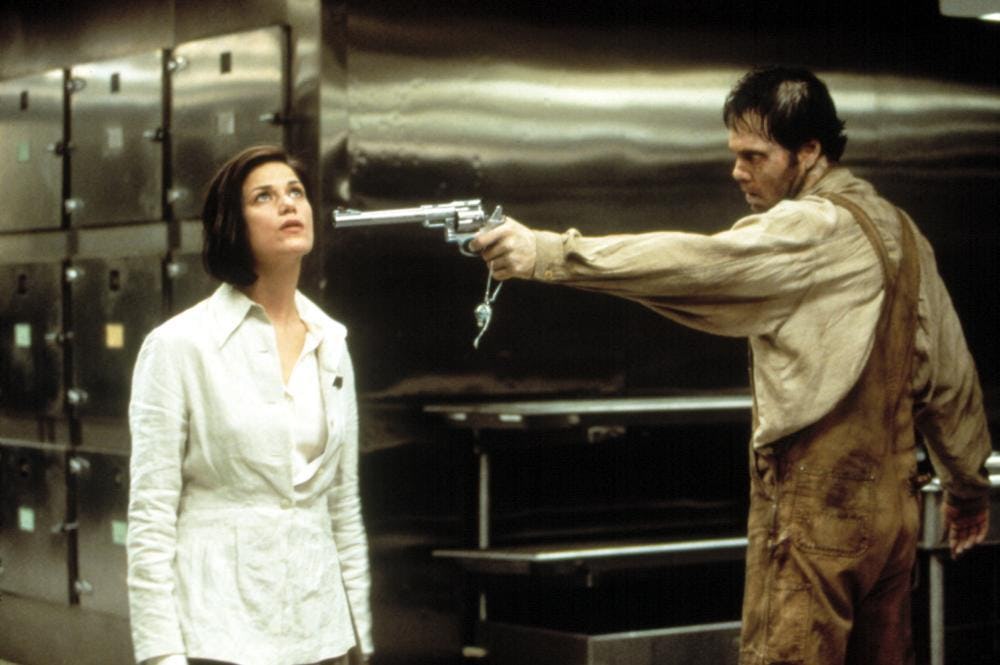
Siobhan Fallon Hogan: The set was up on this hill. It starts raining cats and dogs so the first several days we couldn’t get up the hill. Rick Baker had to load poor Vincent D’Onofrio up with makeup. It’d be time to get the truck, and they couldn’t get the truck up the hill. There’s not enough traction in Los Angeles soil.
David LeRoy Anderson: He has his eye pulled down and the skin rolled over so he has a constantly drooping eye on one side.
Siobhan Fallon Hogan: I distinctly remember them coming up and having to put eye drops in him because literally his eyes were pulled down so low.
David LeRoy Anderson: Also on his left side we have an added piece of lip thickness that’s giving a little stroke to that side of the face, and he’s wearing a denture plumper on the inside of his mouth too. He basically wore this silicone neck — it was like a skin turtleneck — that blended off right on his beard line. When he pulls his face back, the majority of it was a sculpted forehead with a piece that he could grab that came way back that he could grab this whole handful. The silk patches were attached to the sides of his mouth, and they were buried underneath a silicone appliance that blended off so when he pulled he could functionally stretch his whole face back by pulling harder.
The aliens
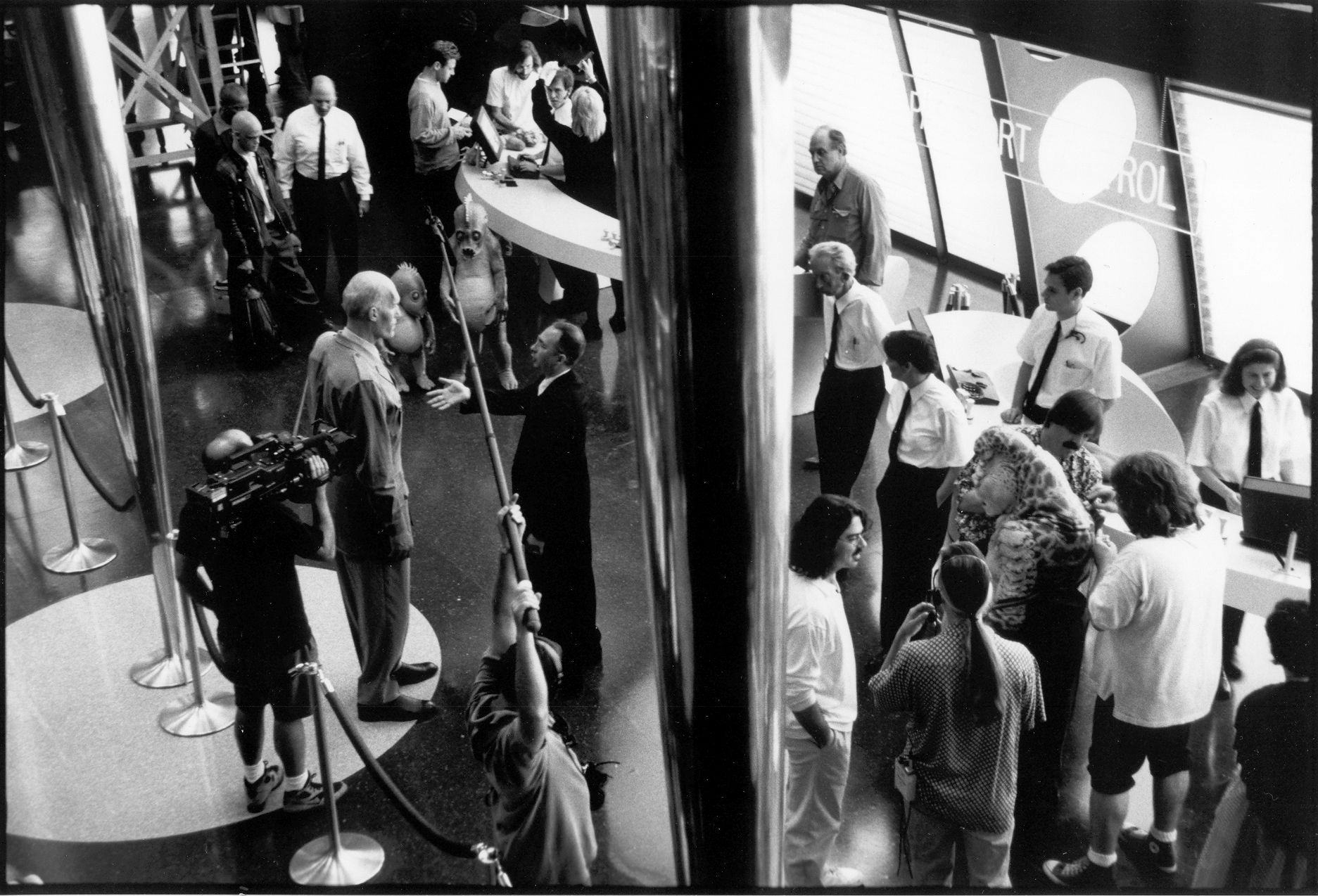
Sergio Calderon (actor, Jose): Saturday morning I woke up at five, six, seven – I had some kind of insomnia – so I decided the best thing to do was smoke a joint. So I went to sleep very happy. All of a sudden I had a phone call from my agent. So I took a shower and immediately went to the audition on Sunset Boulevard. Debra Zane [casting director] said, “They have a character: some guy from another planet but we don’t know what he does.” My hair was very long, it was like a woman’s, so I took my hair and shook it up, and I went, [mimes going crazy like an alien]. That was the only thing I did.
Carel Struycken: I was a known entity by then. Back then I was a little over seven feet. I did have acromegaly. It’s what they call a benign tumor on the pituitary [gland]. It produces too much growth hormone. By the time I was 14, I was already almost two meters. The time in the morgue, Tommy Lee Jones – he’s a serious method actor, right? – he actually tried to teach me how to be dead, which at first was very funny.
Brad Abrell (actor, Mannix the Worm Guy): The script called for the worm guys to be conversing in some gibberish alien language in the coffee room. When Tommy Lee Jones asked my worm, “Don't tell me we only have that powdered stuff," my answer to him was just improvised gibberish on the spot. A few words here and there were crafted beforehand: ‘zabumba’, ‘cahuengas’, etc. Contrary to growing internet rumors, the language is not an offshoot of Huttese (from Jabba the Hutt). Tommy, by the way, was fascinated by the creatures and took pictures of them to show his son.
Lowell Cunningham: Barry Sonnenfeld approached me and said, “We need to get you on the screen.” When J and K are in the headquarters looking at the big screen, with all the famous people who are secretly aliens, the camera flips back to J and K and I’m visible behind them. Did I have my glasses on? Yeah, I think I probably left my glasses on because I needed to see where I was walking.
David LeRoy Anderson: About the time the sun was coming up, we’d step out of the trailer for a cigarette and Edgar [Vincent]’s in full character, and people are walking around the streets of the meat-packing district, bumming cigarettes from him and not even looking twice at the fact that he’s got nails growing out of his knuckles, his whole face is all fucked up, he’s got big bald spots all over the place. Didn’t matter at all.
“Will was always great”
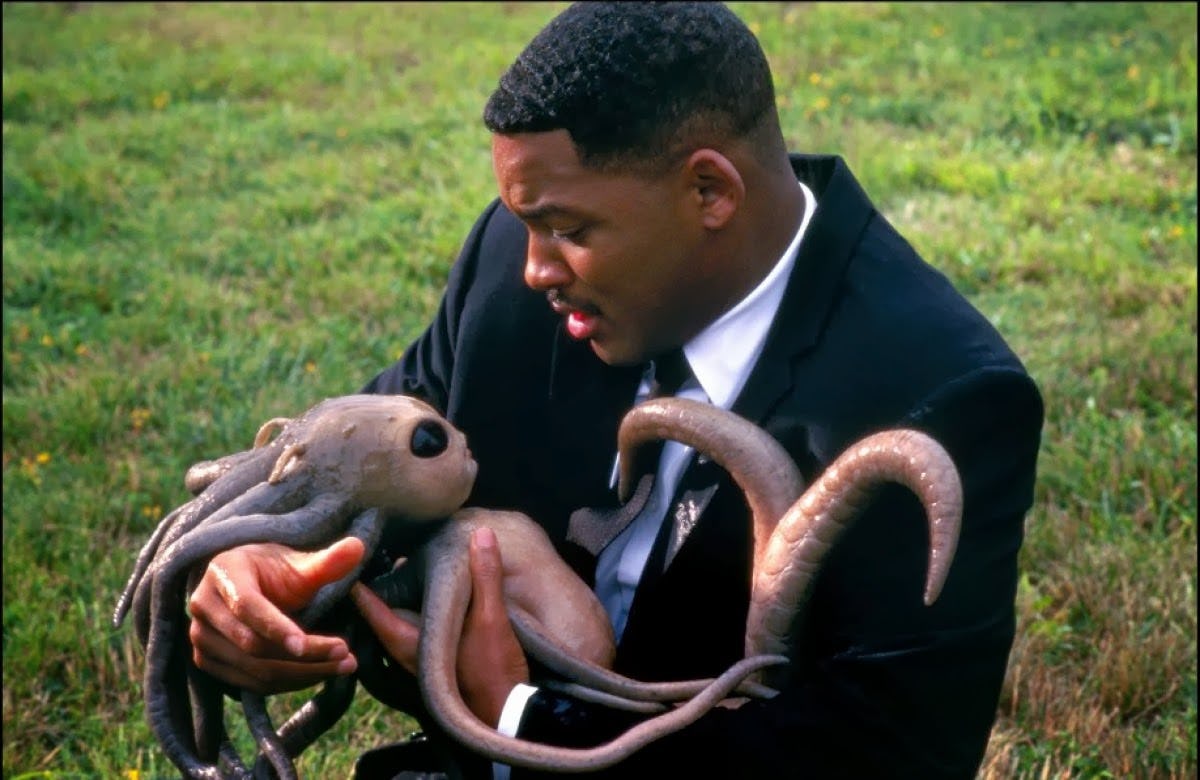
Thomas Duffield: Will was always great. I never saw him even mad on the set. He gave everybody a bottle of Don Perignon at the end.
Brian Smrz: There’s a thing where he gets sucked out of a car through the side window. Will Smith’s supposed to come out first so he basically had to be folded over like a pancake. No normal person can get that flat. I actually got a guy who was brand-new in the business.
Clay Fontenot (stunt man): Once I was in the box in the right position with the cable set at the correct length, they had me bend over at the waist and place my head on the floor between my knees with my legs straight. Now folded in half like a taco, they were able to place the lid on the box and screw it into place, locking me in. They would push the button on the ratchet and the cable would draw tight and yank me out of this box by my rear end as if I was in the car and being pulled out of the car window butt-first by the creature’s tentacle.
Tommy Lee Jones
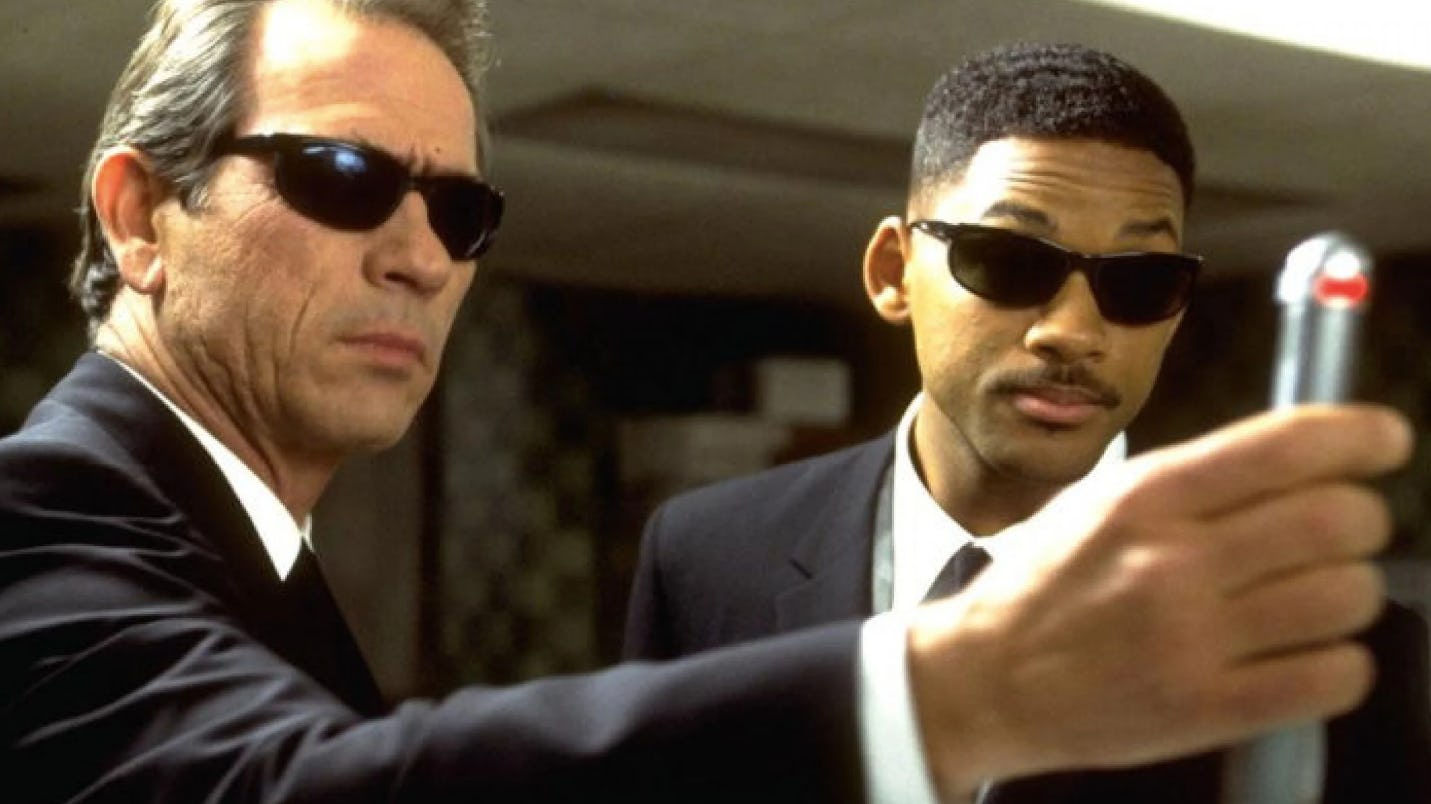
David Rubin: The important thing in casting the Tommy Lee Jones character was to find someone who wasn’t going to lean into the comedy.
Barry Sonnenfeld: Tommy just hadn’t been in comedies and just didn’t know that you just need to play the same reality as you do in dramas.
Mary E Vogt: Tommy lives in San Antonio and he didn’t want to come to LA for a fitting. I said, “You don’t have to come, I’ll come to you.”
“You could say he’s gruff but he’s serious and he’s a fricking amazing actor.”
Barry Sonnenfeld: Tommy didn’t think that I knew what I was doing. I would get calls from his agent at the time, saying, “You only want Will Smith to be funny; you don’t want Tommy to be funny.” Very first day shooting with Tommy, he’s talking to Mikey, the multi-flippered alien in the Sonoran desert. Tommy’s line to Mikey is “That’s enough, Mikey. Put up your hands and all your flippers.” It’s only funny if Tommy doesn’t acknowledge that’s a funny line. But Tommy goes, “That’s enough, Mikey. Put up your hands - AND… ALL YOUR FLIPPERS!”
Bo Welch: And Barry says, “Woah woah woah woah, no no no no.” Tommy says, “I’m in a comedy.” And Barry says, “Yes, you’re in a comedy but it’ll be much funnier if you’re as flat and as dry and as business-like to contrast with Will Smith.” So Tommy had to wrap his head around that. He did it but he was kind of a pain in the ass during the shooting.
Ed Solomon: It was my experience that if he knew it was a comedy he certainly didn’t think it was funny — and he let me know on quite a few occasions.
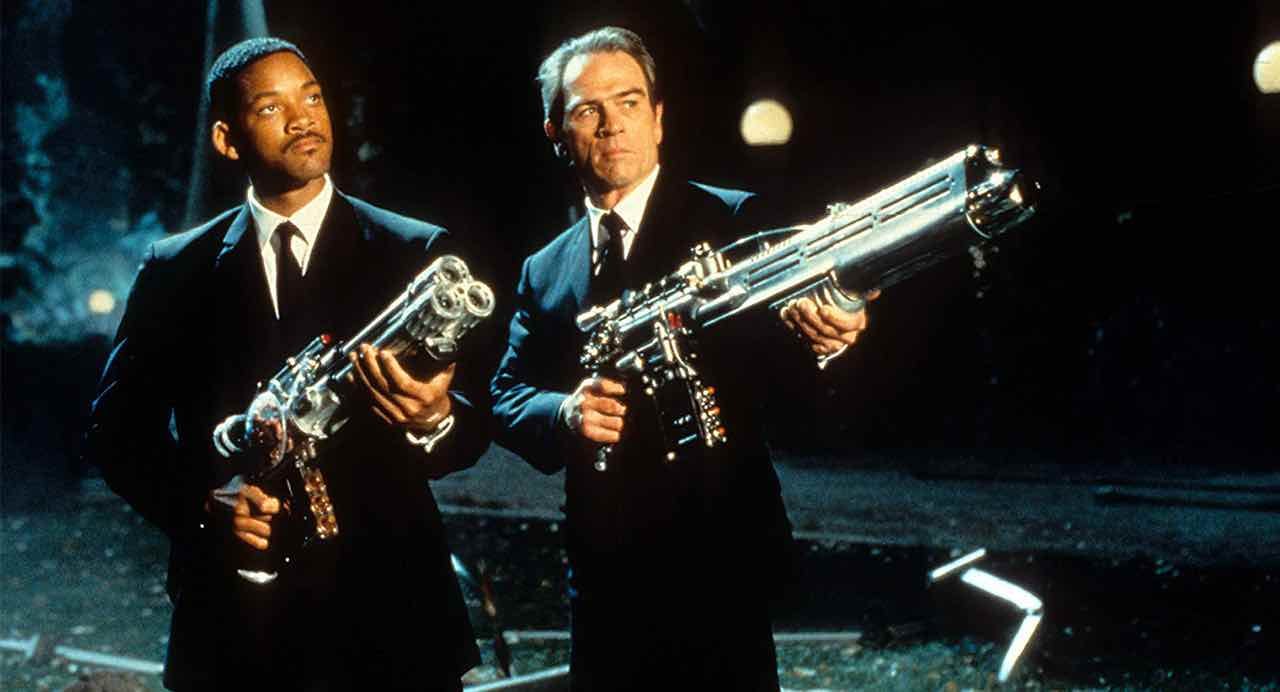
Sergio Calderon: He is a little bit difficult. Not with me because he knows me. We understood each other very well.
Siobhan Fallon Hogan: Tommy’s hysterical to me. You could say he’s gruff but he’s serious and he’s a fricking amazing actor.
Brian Smrz: Tommy Lee Jones is a lot rougher [than Will Smith] so I’m glad I didn’t have to do too much with him, to be honest. My first meeting with him, I said, “Hey, hello,” and put my hand out to shake his hand. He didn’t even put his hand out, he’s like, “My double’s Cliff Happy. Use him and we’ll get along fine.” And then he turns around and walks away. To me, that kinda summed him up.
Ed Solomon: His performance really upgraded the script in a pretty significant way. Sometimes I’d write a whole paragraph that I would just see him X out with his pen and then just do it in a look.
Barry Sonnenfeld: At the end, when Tommy asks Will to neuralize him, I think it’s quite moving. He loved his performance. In all the interviews, they said, “How did you get to be so funny?” And Tommy, God love him, said, “The secret to being funny is to stand next to Will Smith and do whatever Barry Sonnenfeld tells you to do.”
The big finale
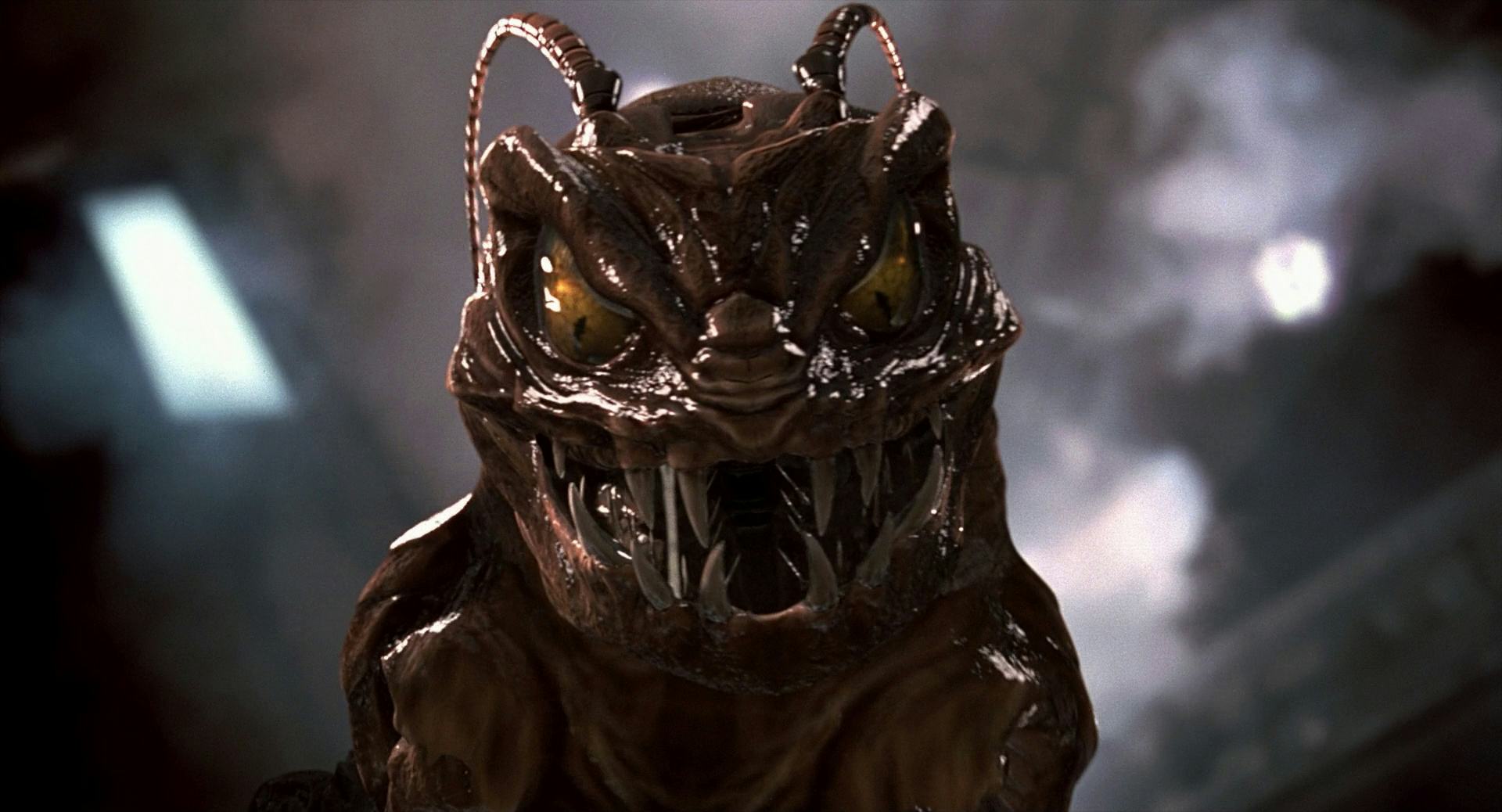
Bo Welch: Barry’s on stage, about to have a nervous breakdown, and then they basically rewrote the ending within weeks of shooting it.
Barry Sonnenfeld: I kept saying, “We have an action-adventure comedy with very little action and very little adventure.”
Ed Solomon: They were originally trying to do it in-camera, puppeted.
Barry Sonnenfeld: Rick had spent close to $1 million building an animatronic 18- or 20-foot Edgar bug. It could bend but it couldn’t walk.
Ed Solomon: I remember Eric Brevig, who was the visual effects supervisor, saying, “Guys, you’re gonna need to do it in visual effects.”
“Rick had spent close to $1 million building an animatronic.”
David LeRoy Anderson: It did not go well on set the day that Rick learned that the bug was going to be completely CG because they had worked their butts off.
Ed Solomon: My ending was probably a little bit more complex than the movie warranted. I always wanted it to be a more philosophical thing.
Barry Sonnenfeld: That ending was a talk-fest between Will and the Edgar bug about the nature of the universe and about fear. Finally, Walter and Laurie said, “Oh my God, you’re right. We can’t have this ending.” So we realized we were gonna have to add a lot of CG.
“It was a hit”
Ed Solomon: I remember going to see a screening of the film and being really emotional afterward in a positive way because the making of the film was very stressful for me: the multiple years; the multiple, multiple, multiple drafts…
Thomas Duffield: It was a hit right out of the box.
Siobhan Fallon Hogan: I was like, ‘Oh my gosh. I think the audience really likes this.’ It was completely something like I’d never seen. It’s so strange when you’re in it, and you’re just rooting for it like you’re rooting for a horse in a horse race.
Barry Sonnenfeld: I loved being under the radar. It’s a small movie pretending it’s a big movie and I like those.
Bo Welch: I knew it was gonna be great when I was surfing in Malibu. I was sitting out on my surfboard and one of those planes that drags the sign behind it went by, and it said “Men in Black” and the date. And I went, “Holy sh*t. Now I know.”
Lowell Cunningham: I’ve seen some of the great sights of the world, like the Great Wall and the Eiffel Tower. I have been to every continent now. I didn’t actually set foot on Antarctica but I was close enough to distinguish individual penguins on the shore. I would never have been able to do a fraction of that without the success of Men In Black.







